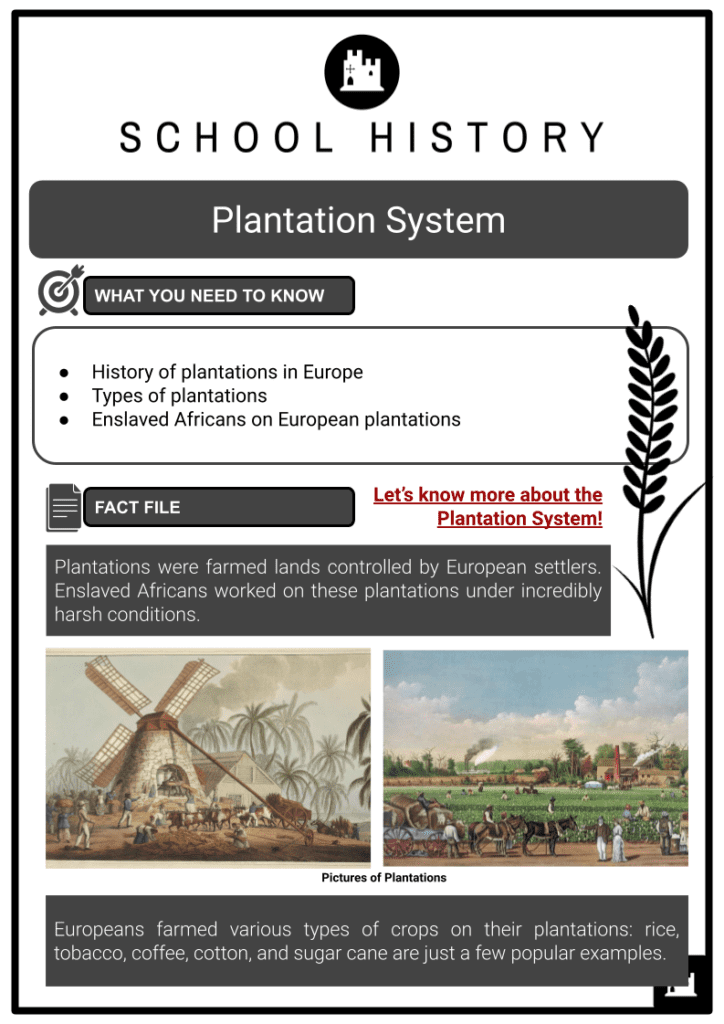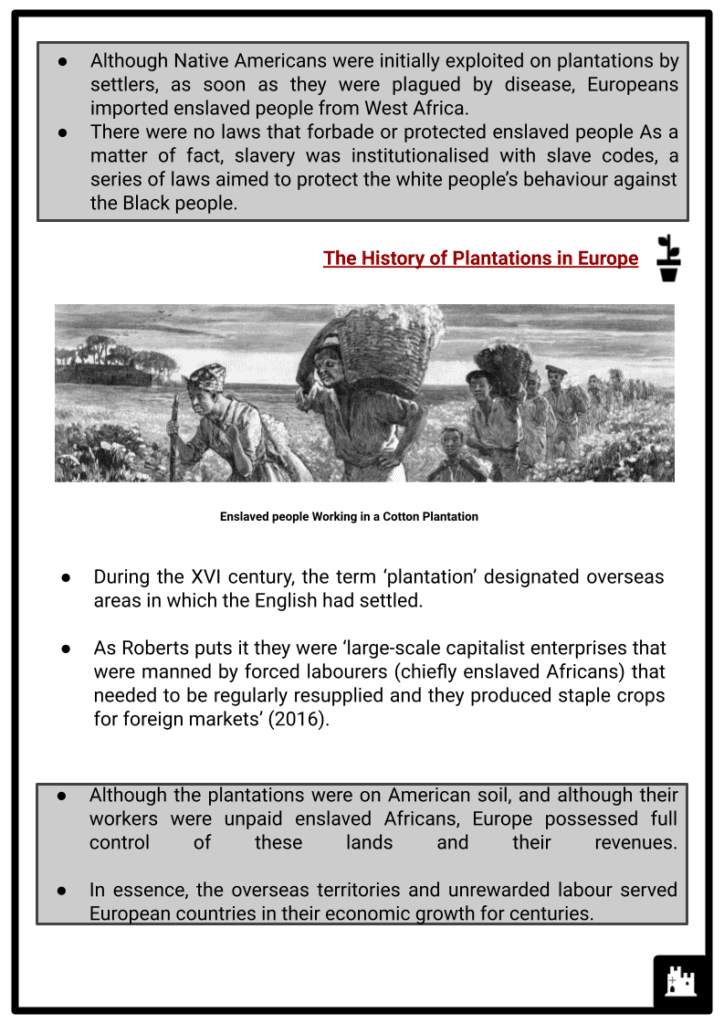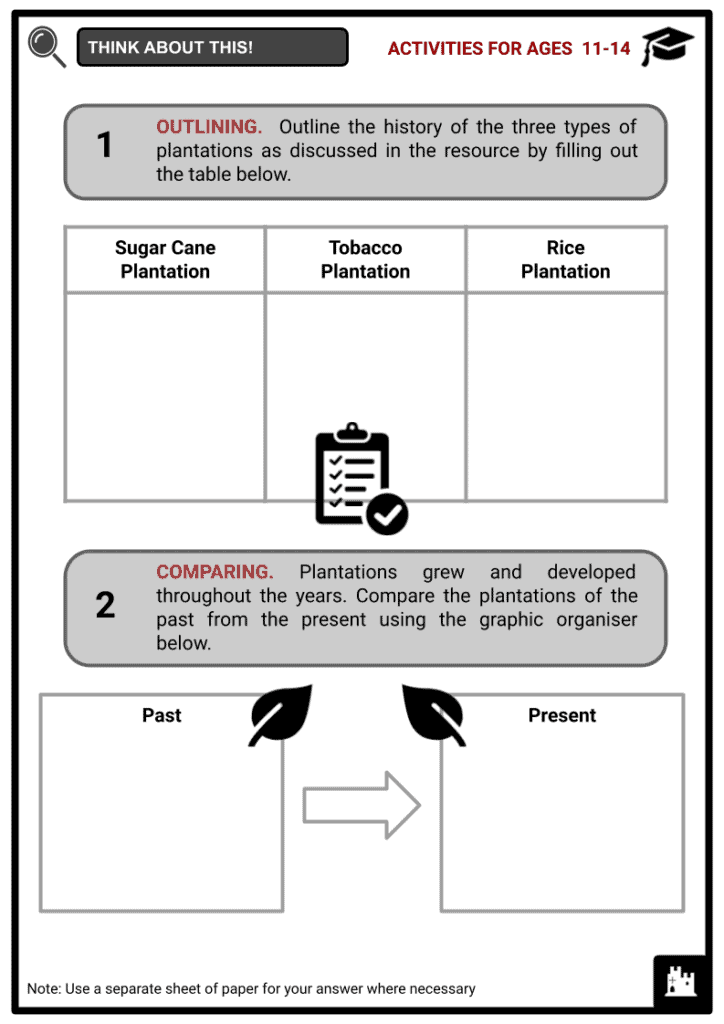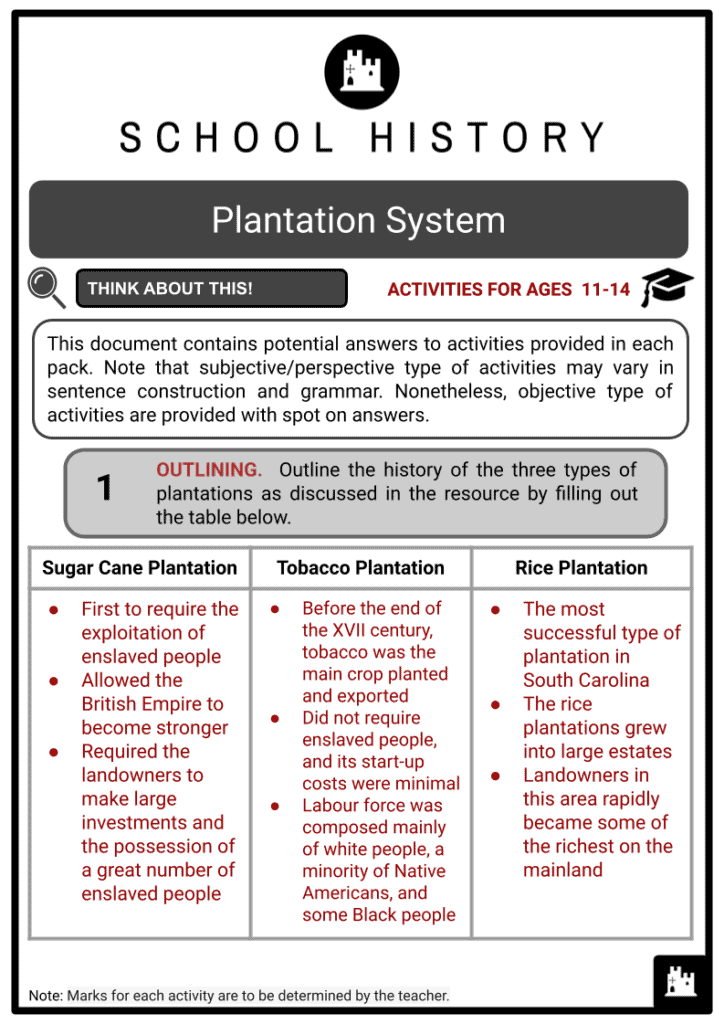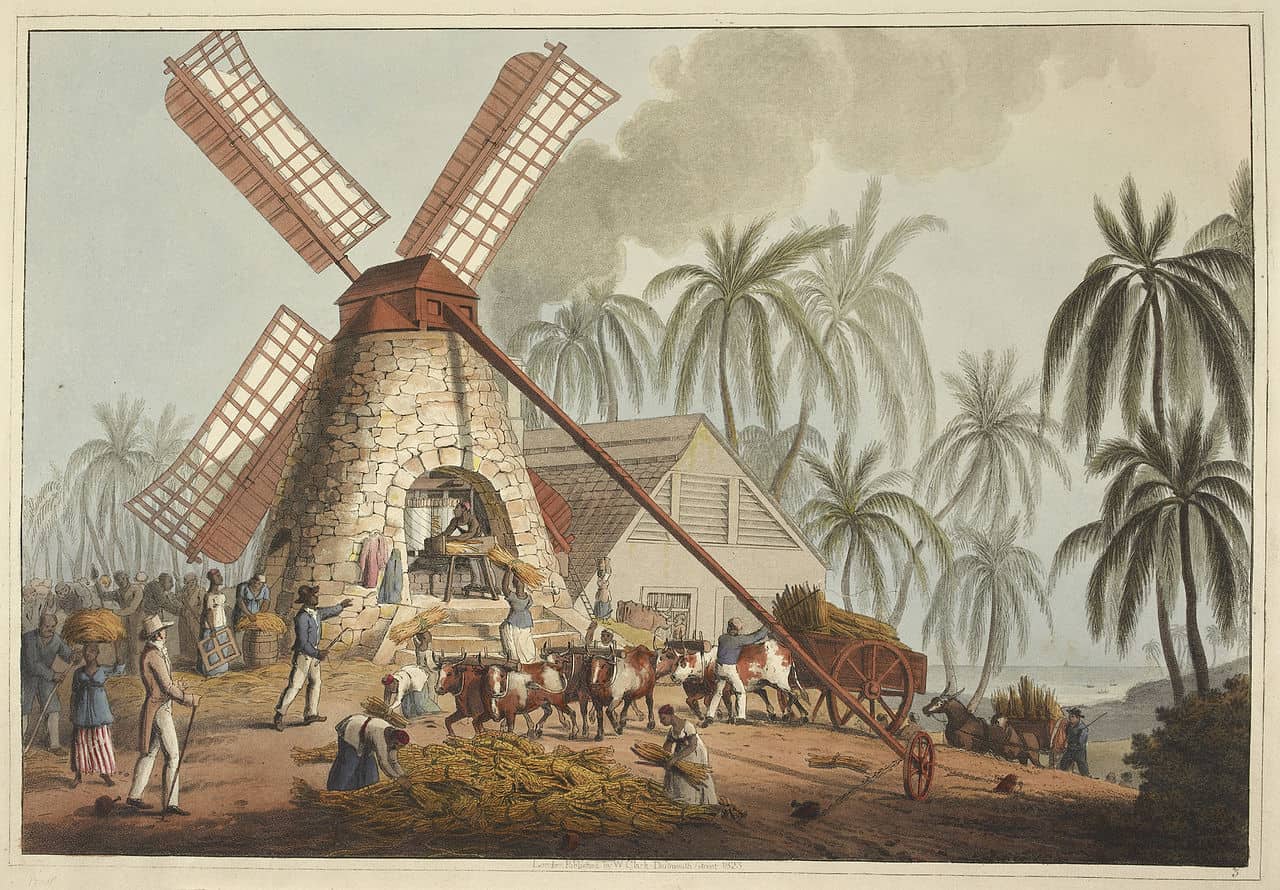Download Plantation System Worksheets
Do you want to save dozens of hours in time? Get your evenings and weekends back? Be able to teach Plantation System to your students?
Our worksheet bundle includes a fact file and printable worksheets and student activities. Perfect for both the classroom and homeschooling!
Table of Contents
Add a header to begin generating the table of contents
Summary
- History of plantations in Europe
- Types of plantations
- Enslaved Africans on European plantations
Key Facts And Information
Let’s know more about the Plantation System!
- Plantations were farmed lands controlled by European settlers. Enslaved Africans worked on these plantations under incredibly harsh conditions.
- Europeans farmed various types of crops on their plantations: rice, tobacco, coffee, cotton, and sugar cane are just a few popular examples.
- Although Native Americans were initially exploited on plantations by settlers, as soon as they were plagued by disease, Europeans imported enslaved people from West Africa.
- There were no laws that forbade or protected enslaved people. As a matter of fact, slavery was institutionalised with slave codes, a series of laws aimed to protect the white people’s behaviour against Black people.
The History of Plantations in Europe
- During the XVI century, the term ‘plantation’ designated overseas areas in which the English had settled.
- As Roberts puts it they were ‘large-scale capitalist enterprises that were manned by forced labourers (chiefly enslaved Africans) that needed to be regularly resupplied and they produced staple crops for foreign markets’ (2016).
- Although the plantations were on American soil, and although their workers were unpaid enslaved Africans, Europe possessed full control of these lands and their revenues.
- In essence, the overseas territories and unrewarded labour served European countries in their economic growth for centuries.
- However, when the British economy started flourishing and more jobs became available, cheap labour was still needed in the plantations in order to sustain the growing demand for products that were to be exported to Europe.
- As a consequence, importing enslaved people from Africa became a ‘morally, legally and socially acceptable’ trend both within Europe and the new colonies (Timmons 2018).
- Britain played a fundamental role in the colonisation of the Americas and ended up controlling thirteen colonies (along with Scotland).
- These were Delaware, Pennsylvania, Massachusetts Bay Colony, New Jersey, Georgia, Connecticut, Maryland, South Carolina, New Hampshire, Virginia, New York, North Carolina, and Rhode Island.
- Initially, when European settlers took over the new land, Native Americans were forcefully exploited and obliged to work on the plantations.
- During the XVI century, the term ‘plantation’ designated overseas areas in which the English had settled. Examples of such zones included Massachusetts Bay and Virginia.
- European countries, such as England, viewed the New World as an infinite resource of riches and primary goods, able to provide them with wealth.
- The settlers were able to thrive by exporting the natural resources that these lands had to offer and exotic goods started to be exported from the Americas to Europe.
Types of Plantations
- The Caribbean offered the production of sugar, whereas Virginia was exploited for its tobacco production.
- During the XIX century, the southern US produced much cotton, and Cuba was able to raise its economic value through the sugar revolution.
- Rich land-owners planted a variety of crops such as coffee, rice, sugar cane, and tobacco.
- In order to sustain the massive amount of work on their fields, landowners were soon obliged to recruit more people to work on their farms.
- For this reason, they purchased enslaved West-Africans from slave traders, giving way to a new type of industry: the slave trade and the ‘slave auction’ (Timmons 2018).
- However, the first wave of enslaved Africans that arrived in Virginia was not described as 'slaves': in fact, at the beginning of the XVII century, the censuses simply listed them as ‘negroes’ (Roberts 2016).
Sugar Cane Plantation
- In the XVII century, sugar cane plantations were the first to require the exploitation of enslaved people.
- In fact, in Brazil, landowners employed Brazilian natives. However, the conditions and the treatments they were exposed to rapidly caused them to be plagued by diseases, and the immediate need to replace their workers pushed colonisers to import enslaved people from Africa (Roberts 2016).
- Sugar plantations allowed the British Empire to become more and more strong. Sugar plantations also appeared in Barbados, Jamaica, in the Lesser Antilles and in the Greater Antilles.
Tobacco Plantation
- Before the end of the XVII century, tobacco was the main crop planted and exported (Great Britain was one of its largest importers with over twenty million pounds per year).
- Timmons (2018) reports that in 1622, sixty-thousand pounds of tobacco had been exported, and in 1639, its exports had reached over 1.5 million.
- Tobacco plantations were also spread throughout Chesapeake, and although the British tried planting the crop on the eastern shore, it had little success.
- Whilst sugar-cane plantations required the landowners to make large investments and the possession of a great number of enslaved people, the tobacco business, on the other hand, did not require enslaved people, and its ‘start-up costs [..] were minimal’ (Roberts 2018).
- In fact, the Chesapeake tobacco plantations had no enslaved people. The crops were handled by ‘self-reproducing populations’, and very often, also the landowner worked in the fields (Roberts 2018).
- As a consequence, their labour force was composed mainly of white people, a minority of Native Americans, and some Black people (who were generally regarded by society as enslaved people).
Rice Plantation
- In South Carolina, the most successful plantations were those producing rice, and they employed huge populations of enslaved people.
- The rice plantations grew into large estates, and rice started dominating the economy of South Carolina because of its exports.
- Landowners in this area rapidly became some of the richest on the mainland (Roberts 2016; citing McCusker and Menard 1985).
- The plantation system allowed America to ‘have a transformative impact on ecology, economy, culture, and social structure’ (Roberts 2018).
Slavery in Plantations
- Although most enslaved people were Africans, it is necessary to note that the ‘English used other populations of vulnerable and exploitable labourers’. For instance, they employed prisoners, convicts, Irish, and native populations (Roberts 2016).
- In the British-American colonies, there were no rules or laws that defined or protected the status of enslaved Africans. Only a few of them were able to escape slavery, and even fewer – such as the African Anthony Johnson – were able to have ‘servants of their own’ (Roberts 2016).
- Enslaved people were purchased at auctions and were generally treated like animals. After being heavily inspected by their potential buyers, they were sold to the highest bidder.
- According to Timmons (2018), a relatively healthy and strong enslaved person would cost around today’s equivalent of $1,200-$1,500.
- Slavery had made the U.S. South incredibly prosperous since it was producing over 75% of the world’s cotton (Timmons 2018).
- The relation between the enslaved and their enslavers had a ‘paternal character’ (Novack 2005).
- The enslavers supervised their enslaved people and the work they carried out. They were not concerned with the harsh treatment their workers received, and were only interested in the profits they could gain (Novack 2005).
- Enslaved Africans who worked in the fields, as well as those who served in households, were treated in the most inhumane manner.
- The following description of the work conditions endured by enslaved African-Americans is an excerpt from Ulrich B. Phillips’ work, The Documentary History of American Industrial Society.
- ‘The labourers were strictly classified and worked in squads under close and energetic supervision to near the maximum of their muscular ability. The routine was thoroughly systematic, and the system as efficient on the whole as could well be, where the directors were so few and the Negroes so many and so little removed from the status of African savagery. The Jamaican units were on the average the largest in all the history of plantation industry’
- (Novack; citing Phillips)
- Moreover, since settlers started fearing potentially serious revolts, slave codes were introduced on the plantations in order to institutionalise slavery.
- For instance, such laws stated that it was illegal to provide enslaved people with basic education (such as reading and writing), it was forbidden to organise meetings and assemblies without the presence and surveillance of a white person and enslaved people could not testify against a white person in court.
- Therefore, enslaved Africans received subhuman treatment. They were forced to work up to eighteen hours per day, including the weekends (they did not have a day in which they could rest), children over six years old were forced to work, enslaved people were the subject of draconic laws and were punished with harsh mental and physical tortures when their enslavers deemed it was necessary.
Image sources:

